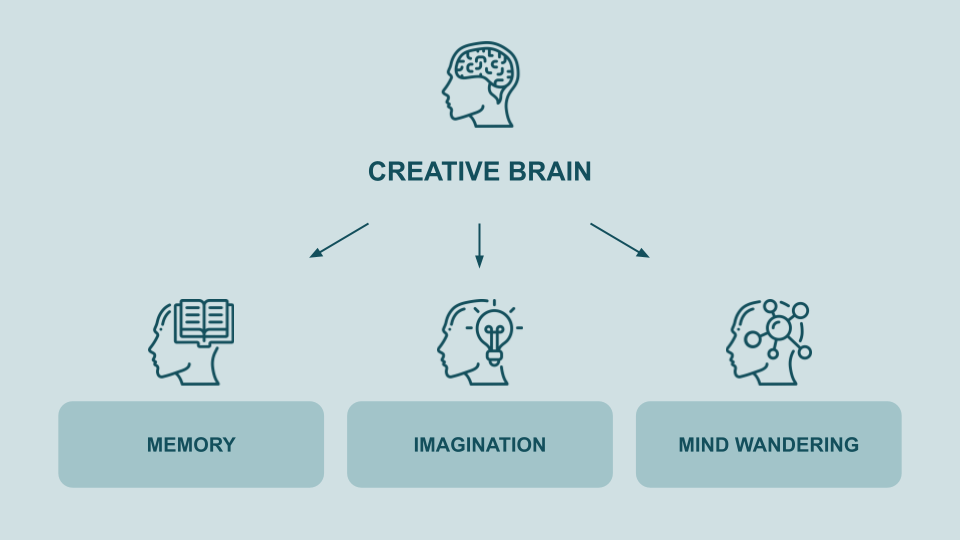Creativity is everywhere around us — in the random colors of an artist’s painting, the verses of profound poetry, or an inspiring sculpture crafted from muddy clay. However, being creative is not just related to the arts, and artists are not the only custodians of creativity. Solving challenging problems, coming up with new technology, finding ways to better communicate with others… These are all examples of creativity. So, how can you cultivate your creative thinking? Understanding the relationship between your brain and creativity can give us a few helpful cues.
The brain-creativity relationship
Where does creativity stem from a biological and psychological standpoint? Historically, there has been a prevalent view that creativity comes from the brain’s right hemisphere. Creative people were thought to be “right-brain thinkers”, and analytical people to be “left-brain thinkers” — which has since been shown to be an oversimplified view of the brain-creativity relationship. Creativity emerges from the complex interaction of several parts of the brain across both hemispheres.
Being creative partly comes from our aptitude to envisage the future and our capability to visualize experiences that have not yet arisen. Interestingly, the part of the brain involved in thinking about the future is also associated with recollecting the past; this area is called the hippocampus, a seahorse-shaped portion deep in the brain’s temporal lobe that plays an essential role in consolidating the details of our experiences, including places, people, objects, and actions. The hippocampus is involved with precisely reconstructing historical events and building frameworks for potential events in the future.
But other brain regions get activated as well when you evoke past events and visualize future experiences. A key network of such brain regions is called the “default mode network”, which includes connected areas such as the medial prefrontal cortex, the posterior cingulate cortex, the bilateral inferior parietal lobes, and the medial temporal lobes.
These areas are activated by default (hence the name “default” mode network) when people are in a relaxed state inside a brain scanner and do not perform any cognitive task. In this state, the human brain engages in all kinds of spontaneous thoughts — an experience you may know as mind wandering.
There is a consistency in the involvement of the default mode network and the hippocampus in recalling and imagination. The “constructive episodic simulation hypothesis” suggests that both imagination and memory are associated with flexible recombination of details from past events — including places, people, and events — into novel scenarios. By allowing us to link data in innovative and meaningful ways, the episodic system’s versatile nature is considered to be especially useful for creative thinking.
A study led by Dr. Roger Beaty from Harvard University further explored how these regions of the brain were involved in recalling, imagination, and creativity. The subjects were presented with a succession of object clue words — for example, “cup” — and were asked to use these words for one of the following: recalling a past experience, imagining a future event, or thinking of creative usages of the object.
The goal was to identify the brain regions that were mutual or unique for recalling, imagination, and creative thinking. The results suggested that memory, imagination, and creativity all triggered the hippocampus as well as a core network of brain regions which largely overlaps with the default mode network.
While there is still much to study to fully understand the brain-creativity relationship, early research points to the default mode network and the hippocampus as key areas for creative thinking. We may be able to improve our creativity by applying strategies to better recall our past, visualize our future, and let our mind wander to trigger these key areas.
How to cultivate your creative thinking
We are all already experiencing everyday creativity, whether we produce a new connection between existing ideas, solve complex problems, or navigate a tricky situation. However, a few simple habits can help us enhance that creativity further.
- Create on the shoulders of your past. Your ability to recall past experiences and recombine them in novel ways will help you become more creative. In order to better remember past events, consider taking notes or journaling. The act of writing down your thoughts will help you reinforce these memories so they are more easily accessible in the future.
- Practice creative visualization. Connecting ideas together is a great way to visualize the future and to come up with innovative solutions to tough problems. You could simply brainstorm various scenarios, or use mind mapping to link concepts together. You don’t even need to be sitting at your desk: asking yourself “what if?” while taking a walk is a great way to practice creative visualization.
- Make space for mind wandering. Finally, activate your default mode network by doing… Nothing. Which is easier said than done. If doing absolutely nothing sounds too challenging, try simple activities that do not require your brain to focus too much, such as going for a walk, taking a shower, or cooking a simple meal.
In essence, creativity is not really about building something new out of thin air. It’s about using your past experiences, connecting the dots to visualize the future, and letting your mind wander so you can experience more eureka moments. Maintaining a more creative brain requires building a few habits to tap into the three key aspects of the brain-creativity relationship: memory, imagination, and mind wandering.

